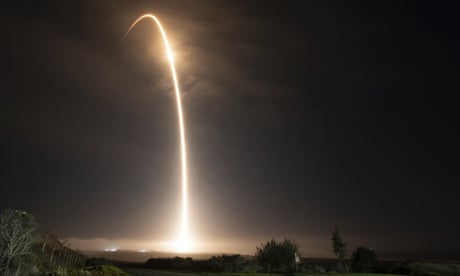Most mission scientists would wince at the thought of their spacecraft being smashed to smithereens. But for those behind Nasa’s Dart probe, anything short of total destruction will be chalked up as a failure. The $330m (£300m) spacecraft is due to slam head-on into an asteroid about 11m kilometres above the Indian Ocean soon after midnight on Monday.
The impact, at nearly seven kilometres a second, will obliterate the half-tonne probe, all in the name of planetary defence. Not that Dimorphos, the asteroid in question, poses any threat to humanity. The Dart, or double asteroid redirection test, is an experiment, the first mission ever to assess whether asteroids can be deflected should one ever be found on a collision course with Earth.
A well-placed nudge could avert Armageddon, or so the thinking goes, and spare humans the same fate as the dinosaurs. An artist’s impression of a large asteroid colliding with Earth in an event that helped to wipe out the dinosaurs 66m years ago. Photograph: Science Photo Library/Alamy “It’s a very complicated game of cosmic billiards,” said Prof Alan Fitzsimmons, an astronomer and member of the Nasa Dart investigation team at Queen’s University Belfast.
“What we want to do is use as much energy [as we can] from Dart to move the asteroid. ” With telescopes constantly scanning the skies, scientists hope to have some notice if an asteroid were ever to present a major threat. “If we are able to see far enough in advance and know that an asteroid might be a problem, pushing it out of the way will be much safer than the big Hollywood idea of blowing it up,” said Catriona McDonald, a PhD student at Warwick University.
The Dart mission launched from Vandenberg space force base in November last year. On Monday night, mission controllers will hand control to Dart’s software and let the probe steer itself into oblivion. The collision, at about 12.
14am on Tuesday, UK time, will be recorded by Dart’s camera and two more onboard a small Italian probe called LiciaCube, which Dart released last week to witness the spectacle from a safe distance. When playing with the motion of heavenly bodies, it pays to exercise some caution. The Dart mission has been planned so that it does not inadvertently knock Dimorphos on to a collision course with Earth.
The 160 metre-wide rock orbits a second, larger asteroid called Didymos. When Dart collides, the impact will do nothing more than raise a cloud of debris and slow Dimorphos down, adding a few minutes to its orbit around the larger body. “There’s no danger in this whatsoever,” said Prof Colin Snodgrass, an astronomer and member of the Dart mission science team at Edinburgh University.
“We are only changing its orbit around the bigger asteroid, we’re not changing its orbit around the sun. It cannot come towards Earth. ” Astronomers will use ground-based telescopes to observe the asteroids before and after Dart collides.
Among them, a new telescope installed at the Turkana Basin Institute in northern Kenya aims to capture the moment of impact and the dust cloud Dart kicks up. The amount of debris will depend on the energy of the impact, the type of rock Dimorphos is made from and whether the material is loosely or tightly bound. “The primary mission is a test of planetary defence, but at the same time, we can learn a lot about the asteroid,” said Snodgrass.
In the aftermath of the collision, scientists will work out how much Dimorphos has been slowed down by the impact. To do this, they will monitor the brightness of the larger asteroid, Didymos, which dims slightly every time Dimorphos crosses in front to complete a lap. Dimorphos currently takes about 12 hours to orbit Didymos, and it is expected to take a few minutes longer once Dart has struck.
People stand at what is believed to have been the impact site of a meteor that exploded over the Russian town of Chelyabinsk in 2013. Photograph: Sergei Ilnitsky/EPA Astronomers track about 30,000 asteroids and comets that pass close to Earth’s orbit. None of the big ones – those comparable in size to the 7 mile-wide asteroid that helped wipe out the dinosaurs 66m years ago – are going to hit Earth in the next couple of hundred years.
But smaller ones are harder to spot and can still cause considerable damage. The meteor that exploded over Chelyabinsk in Russia in 2013 was less than 20 metres wide, but created a shock wave that injured 1,600 people, mostly from flying glass and falling walls. Given past missions to asteroids and powerful computer simulations, do scientists really need to crash a spacecraft into an asteroid to see what happens? Fitzsimmons believes so.
“We know what asteroids are made of, but we often don’t know how they are put together, and we don’t know how much Dimorphos will move when it’s hit,” he said. “You don’t want to wait until one is coming towards you to see if this approach works. ”.
From: theguardian
URL: https://www.theguardian.com/science/2022/sep/25/nasas-dart-probe-to-smash-into-asteroid-in-first-earth-defence-test
